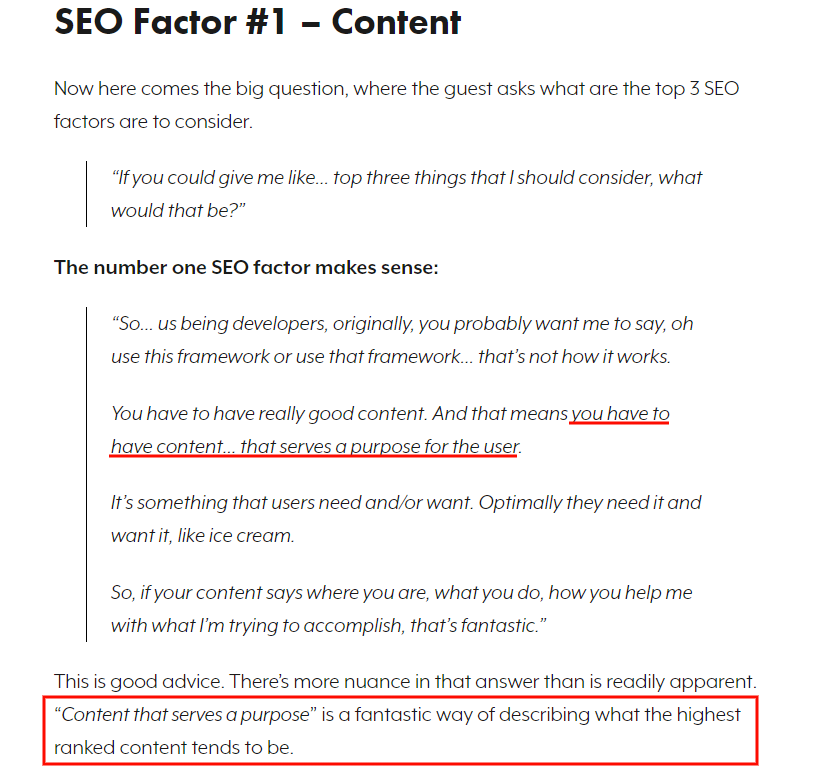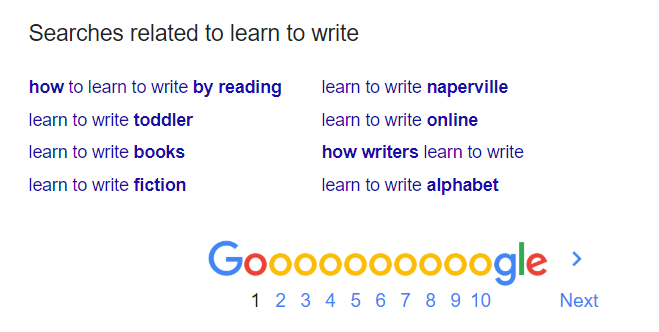If one thing matters more than anything to Google, it’s your content’s relevance to the reader.
(Is it useful? Does it serve a purpose for them connected to their search intent?)
This fact came into focus once again in the first episode of Google’s YouTube series, SEO Myth Busters.
In particular, a Search Engine Journal post by Roger Montti outlines insights from this episode we can apply right now.
The #1 SEO factor mentioned: user-relevant content that serves a purpose.

We see this sentiment about the importance of user relevance echoed in other Google sources, too, like the Webmaster Guidelines:

And the Search Quality Evaluator Guidelines (for example, pages without a beneficial purpose get the lowest page quality rating):

Needless to say, concepts like relevancy and beneficial purpose in your content are vital to ranking well.
The only question left is, how do you craft content that meets or exceeds these standards?
Let me answer that question by using one of my #1 ranking blog posts as an example.
Let’s break it down.
How to Infuse Your Content with Relevancy & Beneficial Purpose to Rank Well in Google
Here’s a good example of a blog post created with reader relevancy and beneficial purpose in mind, called “Learn to Write: The Ultimate Guide to Get You Started.”

To prove how well it’s working, take a look at the SERP for “learn to write” – the post is currently ranking in the #1 organic position.

How did I create this content with a purpose, and earn top rankings in Google?
By hyper-focusing on the reader, letting them inform every step of content creation.
First tip: Use the language your readers are using.
1. Speak to Your Reader (Use Their Language)
To create content that’s useful, that serves a purpose for the reader, you need to use the language they’re using.
This may seem simple, but it needs research backing it up to ensure you’re on the right track.
You can’t just guess at how your readers describe their problems, interests, and desires because you’ll probably guess wrong.
Instead, it’s important to do social listening, talk to actual customers, gather examples, and base the language you use in your content on what you discover.
We have a defined audience we speak to based on a persona we created – a fictional archetype of our ideal customer. This persona stems solely from audience research.
As you can see, our tone of voice and language are laid-back but professional, fun yet never sloppy, direct, engaging, and geared toward a younger, millennial audience.
We never would have pinpointed this tone without audience research!

2. Speak to Your Readers’ Problems
Luckily, audience research does a lot more than tell you who you’re writing for. It also pinpoints your readers’ problems – especially the ones you (and only you, with your unique expertise) can solve, improve, or alleviate.
This is a big, big part of infusing your content with beneficial purpose and relevance.
The reader problem I address in our example blog is relatively straightforward: They may be afraid of writing, but they need to learn to do it better to achieve more in their day-to-day lives.
As an online writing expert with a content agency, I’m uniquely positioned to help them.
Note how I speak to Millennial-centered facets of this problem in our example.
For instance, most of our readers will be young professionals who need to use writing in at least one aspect of their job. I directly address this in the first section:

In particular, I’m reminding them why learning to write matters for them and their particular needs.
If you can answer the question “why should the reader care about this content?” inside the blog you’re writing, that’s a sign you’re on the right track to infusing your content with a purpose.
3. Use Keywords with Your Content’s Purpose & Reader Vocabulary in Mind
The purpose of your content is the problem you’re solving for the reader (and keep in mind that the problem can be as simple as making them laugh and lightening their day or as complex as teaching them how to code a website).
Your keywords should connect to that problem, as well as use the reader’s vocabulary.
- The problem you’re solving: You should be able to condense the reader problem you’re solving (“I need to learn to write more effectively”) into a simpler keyword phrase (e.g. “learn to write”).
- Audience questions: Audience questions will form the keywords you use, too. For example, your readers might be asking Google “how to write well,” “learn to write,” “professional writing,” or “writing for the web.”
- Related terms: If you scroll to the bottom of the SERP for your main keyword, you’ll find related terms users are actually searching as well.

Don’t forget to vet all the keywords you find. Research them with keyword tools and make sure they’re good fits for your brand to target (for instance, if the competition is too steep, small brands have a slim chance of ranking even if your content is amazing, user-relevant, and purposeful).
4. Avoid Industry Jargon & Insider-Speak
Repeat after me: The way you talk about your business/industry/products/services is not the way your customers talk about them.
Undecipherable jargon in your content can be its downfall. It’s like talking about an inside joke with a friend in a room full of strangers – totally awkward for everyone outside that “in-the-know” bubble.
You never want your readers to feel awkward, confused, belittled, or stupid.
That’s why, in our example blog post, we don’t talk about nitty-gritty grammar details like Oxford commas or em-dashes. We don’t go over their heads with spiels about modifiers and determiners.
We definitely don’t include nerdy, writers-only references. (We save those for our team discussions.)
Instead, the focus is on being relatable, relevant, and easy to understand.
When I make references, they’re to universally understood concepts, like salespeople and common sayings.

Insider-speak is for conversations with your work colleagues, not for talking to your audience. Instead, aim to have empathy and put yourself in your readers’ shoes.
Try to understand their problems from their point-of-view and provide the answers in ways they’ll connect with – your content will be better for it.
Crafting User-Focused Content: Make It Priority #1 to Be #1
Content isn’t about you, your brand, or your business.
It’s about the user.
Added to that, Google loves content that serves a beneficial purpose for the user. If it doesn’t help the target reader in a quantifiable way, if it doesn’t answer the question they were asking in the Google search bar, it’s no good.
To make your content shoot to the top of the SERPs, you need to make it useful, purposeful, and relevant. Follow these tips, and you’ll be well on your way.
More Resources:
- How to Write for Users & Search Engines
- 7 Steps to Drive More Conversions with a User-Focused Content Matrix
- Should We Write Content for People or Search Engines?
Image Credits
All screenshots taken by author, August 2019


